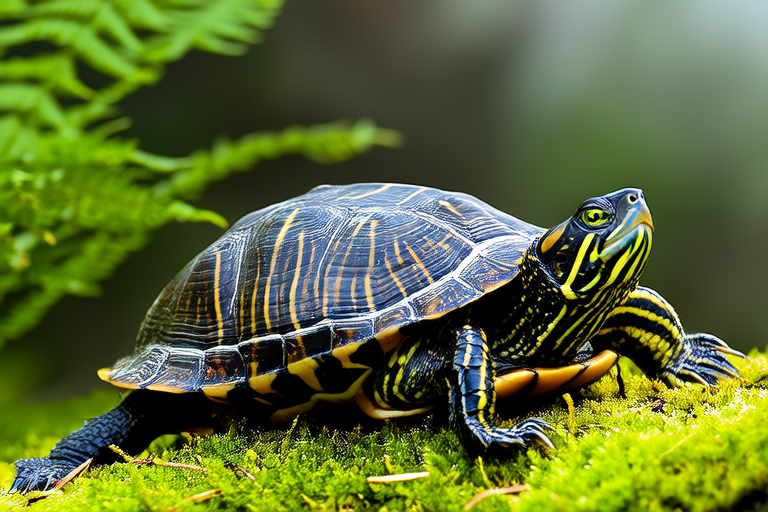The Fascinating World of Three-Striped Box Turtles: From Habitat to Health Care
Three-striped box turtles (cuora trifasciata) are one of the most captivating species within the turtle family. These small, charming reptiles have a unique set of features that make them stand out among other turtle species. With a domed shell that can grow up to 6 inches in length, they possess three distinct yellow stripes running down the center of their dark carapace, which is why they’re named as such. Their plastron (the bottom part of the shell) is hinged, allowing them to close themselves completely inside the shell when threatened, providing excellent protection from predators.
Unique Characteristics and Behaviors
Three-striped box turtles are known for their distinctive appearance and behavior. They are primarily terrestrial, spending most of their time on land rather than in water. These turtles are highly adaptable and can be found in various environments across their range. Their ability to retract their head, limbs, and tail into their shell provides an effective defense mechanism against potential threats.
These turtles are also known for their longevity, with some individuals living over 40 years in the wild. In captivity, with proper care, they can live even longer. Their activity levels vary seasonally; during warmer months, they are more active, while in colder periods, they become less mobile and may enter a state of torpor similar to hibernation.
Natural Habitat and Preferred Climates
Native to parts of Southeast Asia, specifically in regions of Vietnam, Laos, and southern China, three-striped box turtles thrive in humid, warm climates. They prefer forested areas near streams, ponds, and marshes where they can find both shade and water sources. The terrain typically consists of moist soil, leaf litter, and dense vegetation, offering ample hiding spots and food sources.
In these habitats, temperatures usually range between 70°F and 90°F (21°C to 32°C), with humidity levels around 80%. These conditions are crucial for maintaining their health and well-being. They require access to both sunlight and shade, as exposure to UVB light is essential for calcium absorption and overall bone health.
Diet: Wild vs. Captivity
In the wild, three-striped box turtles are omnivores, feeding on a diverse array of foods. Their diet includes insects, worms, slugs, snails, fruits, berries, mushrooms, and occasionally carrion. This varied diet ensures they receive all necessary nutrients for growth and survival. As juveniles, they tend to consume more protein-rich foods like insects and worms, while adults shift towards a more plant-based diet.
In captivity, replicating their natural diet can be challenging but is crucial for their health. Pet owners should provide a balanced diet consisting of commercial turtle pellets, fresh vegetables (such as kale, spinach, and carrots), fruits (like strawberries, blueberries, and melons), and occasional live prey items like crickets or earthworms. It’s important to ensure that any food offered is free from pesticides and harmful chemicals.
Vitamin supplements, particularly calcium and vitamin D3, are often recommended to support strong bones and shell development. However, care must be taken not to over-supplement, as this can lead to health problems.
Common Health Issues and Prevention/Treatment
Despite their hardy nature, three-striped box turtles are susceptible to certain health issues. One of the most common ailments is metabolic bone disease (MBD), which occurs due to calcium deficiency. Symptoms include softening of the shell, weak limbs, and difficulty moving. To prevent MBD, provide adequate UVB lighting, offer a balanced diet rich in calcium, and avoid excessive supplementation.
Respiratory infections are another frequent issue, often caused by cold temperatures or poor ventilation. Signs include lethargy, nasal discharge, and labored breathing. Maintaining appropriate environmental conditions and promptly addressing any signs of illness is key to preventing respiratory infections.
Shell rot, a bacterial infection affecting the shell, can occur if the turtle’s enclosure becomes too damp or dirty. Regular cleaning of the habitat and ensuring proper drainage can help prevent shell rot. If symptoms appear, consult a veterinarian specializing in reptiles for treatment options.
Tips for Creating Suitable Living Conditions
For pet owners considering keeping three-striped box turtles, creating an environment that mimics their natural habitat is essential. A spacious enclosure with plenty of hiding spots, such as logs or rocks, allows them to feel secure. The substrate should be moisture-retentive, like coconut fiber or sphagnum moss, to maintain appropriate humidity levels.
UVB lighting is vital for calcium absorption and overall health. A basking area with a heat lamp can reach temperatures of 90°F to 95°F (32°C to 35°C), while the cooler side of the enclosure should remain around 75°F (24°C). Providing a shallow water dish for soaking and drinking is also important.
Regular monitoring of temperature, humidity, and cleanliness is necessary to ensure the turtle’s well-being. Additionally, routine veterinary check-ups can help detect and address any health issues early.
Responsible Turtle Ownership and Conservation Efforts
While three-striped box turtles make fascinating pets, it’s crucial for owners to approach their care responsibly. Purchasing turtles from reputable breeders helps reduce pressure on wild populations and supports ethical breeding practices. Avoiding the collection of wild turtles for the pet trade is vital for conservation.
Owners should also educate themselves about local laws and regulations regarding turtle ownership, as some areas may have restrictions or require permits. Participating in conservation programs or supporting organizations dedicated to protecting turtle species can further contribute to their preservation.
Encouraging awareness about the importance of habitat protection and reducing human impact on natural ecosystems is also beneficial. By promoting sustainable practices and advocating for wildlife conservation, we can help ensure the survival of three-striped box turtles and other turtle species for future generations.
